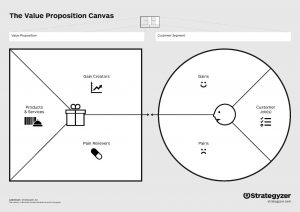
By Kenneth Surbrugg, Director of the Center for Entrepreneurship at Missouri Southern State University
In June, I wrote about business models and how businesses create value propositions (your product or service) to specific customer segments. These value propositions are delivered through different channels (retail brick and mortar, online, etc.) that build customer relationships in order to create revenue streams. The content for this article is taken from the book Value Proposition Design by Alex Osterwalder, Yves Pigneur, Greg Bernarda, and Alan Smith.
This month, I want to introduce the concept of a company’s value proposition – or value proposition concept. The Value Proposition Canvas encourages you to take a closer at your customer segments and how your value proposition fits each of your different customer segments. Below is the Value Proposition Canvas.

On the right side of the Canvas is your unique customer segment. Think of your customers. Who are they? Where do they live? How do they interact with your business offerings? Your customers are just like you – they have specific jobs that they have to complete. These jobs can be their careers, but it goes deeper than that. They may have family, friend, and/or community related responsibilities.
In each of these jobs, your customers have specific “pains” that they are trying to avoid and “gains” that they are trying to achieve. An example of pain avoidance may be that they don’t want to look bad at a company outing, they miss a deadline at work, or they feel that they are out of the loop with community information. Pains tend to embarrass us, or worse.
An example of gain achievement is to close a deal for the company or to get the family car fixed before a trip. Gains tend to make us feel and look good, or better.
Each person is motivated by pain avoidance or gain achievement. Each individual in your customer segment is looking for products or services to do one or the other for specific jobs – avoiding pains or achieving gains. Which of these is the main motivator for your unique customer segments is for you to discover through testing marketing messages or through customer inquiries.
Now think about your own product or service, the left side of the canvas. What jobs are you addressing with your different customer segments? How does your value proposition help customers avoid pains or achieve gains? Do you know how your customers view your value proposition? Understanding how your customers view your company’s value proposition will help you develop marketing messages that deliver results.
For example, suppose you own a cleaning service business. You clean both residential and commercial properties. Now suppose you want to use social media to attract new customers – so you quickly write a post promoting 10% off for any new customer that makes an appointment for a cleaning service, and the offer expires at the end of the month. You boost your post and receive two likes, no comments or shares. So, you do it again with the same results. What is going on? Why are your social media posts doing so poorly? You have an engaging offer – use a great picture – and surely someone needs to have their house or business cleaned – right?
Maybe the customer segment that you targeted does not see a value in your offer. Maybe they are looking for something else – what pain are your potential customers looking to avoid or what gain could they possibly achieve if they used your cleaning business? What messages could your cleaning business develop to highlight one or the other?
It is beneficial to test both messages (one promoting a gain achievement and the other promoting a pain avoidance) and see what works best. Test them both in the same week or in alternating weeks. What is your feedback? If you still are getting little, if any feedback, then try a different market segment. It also may depend on the time of year – the motivation behind having a clean house in August may be a little different than having a clean house in early December before a big holiday party.
The idea behind the value proposition concept is to put yourself in your customer segment’s shoes – what is important to them and what are they looking to accomplish – avoiding pains or achieving gains. Only then can you develop messages to target these customer pains and gains to develop a stronger fit and a loyal customer.








Be the first to comment